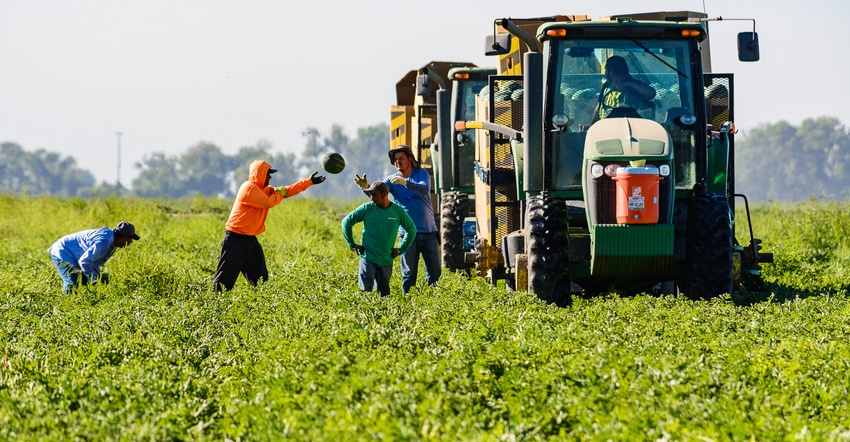
The United States continues to lose out on fresh fruit and vegetable export opportunities as farmers struggle to hire employees for the labor-intensive operations. This struggle, driven in part by sheer numbers of qualified applicants and rising costs to employ that labor is pushing growers and processors towards automation as they seek to be competitive in world markets.
Craig Regelbrugge, national co-chairman of the Ag Coalition for Immigration Reform, speaking at the 2018 Southwest Ag Summit held recently in Yuma, Ariz., said with this country’s land, farming expertise and technology, “we could produce more, but we need labor.”
That’s a problem likely to worsen, and it’s one for which there are no easy solutions with a federal government that has failed over the years to enact meaningful immigration and guest labor reform.
The U.S. Department of Labor reports that the U.S. agriculture industry has between 2 million and 2.6 million “unique” hires. About 75 percent of them foreign born – mostly from Mexico – and half to 70 percent of them are “document challenged.”
Aging labor Force
Many farmworkers are aging out – the average age is 40, and 14 percent are 65 or older. Few new workers are taking their place.
Furthermore, noted Regelbrugge, “migration is basically dead.” Today, less than 5 percent of farmworkers follow the crops as they marry, have families and put down roots.
Farmers increasingly are turning to foreign labor to fill their crews through the H-2A program – 75,000 were certified for fiscal year 2007, a number that surged to 200,049 this fiscal year. Five states: Florida, North Carolina, Georgia, California and Washington, account for 51 percent of the H-2A jobs.
That is a solution said to have its own challenges, including an expensive and cumbersome recruiting process, and stringent wage, transportation and housing requirements.
“We’ve been able to expand our operation because of H-2A,” said Tom Nunes, vice president of operations for Nunes Co., which grows and ships vegetables for the Foxy brand. However, using H-2A comes at a cost as California and Arizona raise their minimum wage rates, and efforts to meet the program’s housing requirements have been stymied by California’s regulatory climate.
Because of this the company is taking a close look at automation.
Tony Tew, area manager of Foothill Packing in Yuma, has been using the H-2A program for 10 years and every year is surprised at the added need for workers. He estimated that of the estimated 18,000 to 20,000 farmworkers in the Yuma area in the winter months, 6,000 are through the H-2A program. Not only are labor shortages seen in vegetables, they now extend to citrus and into the summer months with melon production.
“The shortages never end,” Tew said. “There just aren’t enough workers.”
Despite the challenges to the H-2A program, it has provided farmers who use it with a stable workforce and committed workers.
“I worry less about labor and more about growing my business these days,” said Chalmers Carr III, president and CEO of South Carolina-based Titan Farms and past chairman of the American Farm Bureau Labor Committee. Today he uses H-2A workers in every phase of his farming operation and some 80 percent return each year.
Frustration
At the same time, there is considerable frustration in the agriculture industry over the federal government’s failure to reform immigration and the guest worker program. Any such effort has proven not only futile but “the kiss of death” to supporters, said Carr, who has been trying for 20 years to get immigration reform. Twice the Senate tried to pass immigration reform legislation. The Border Security, Economic Opportunity, and Immigration Modernization Act of 2013 (S744), was supported by the “Gang of Eight,” a bipartisan group of U.S. Senators, and passed 68-32 by the Senate. However, the bill was not considered by the U.S. House of Representatives and died in the 113th Congress.
Currently on the table is the Securing America’s Future Act (HR 4769) introduced in January by House Judiciary Committee Chair Rep. Bob Goodlatte, R-Va. A wide-ranging bill, it would strengthen border security, provide a temporary fix to the DACA (Deferred Action for Childhood Arrivals) problem, mandate the use of E-verify and include the Agricultural Guest Worker Act that Goodlatte proposed in 2017. That bill calls for replacing the H-2A program with a more flexible program known as H-2C.
The Ag Act would provide extended visas for those in year-round agriculture jobs. A concern is that the bill would cap agricultural workers at 450,000, far short of the total the industry projects will be needed in the years to come. The bill also would allow experienced, unauthorized farmworkers to join the H-2C program legally. The catch is that they would have to leave the U.S. voluntarily and return under the H-2C program.
“How many would do that,” questioned Regelbrugge. “I don’t know. There’s no solution in the bill that recognizes the reality of families.”
For now, the conversation is focused on finding a fix to DACA, and any meaningful solution to agriculture’s labor shortage likely must wait.
“My fear is that if DACA goes forward, it will push back labor reform for another six to eight years,” Carr said.
About the Author(s)
You May Also Like




